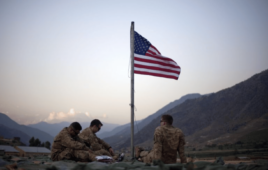
The New Reality in Afghanistan Requires the Afghanistan Government to Change Its Strategy
Since the signing of the U.S.-Taliban Agreement in February 2020, the Taliban has accelerated its offensive, securing major gains. The Taliban has expanded its control of the country and captured border crossings, routing entire Afghan National Army units in the process.
Clearly, the current government strategy is failing. The Afghan government should realize the fact that without the presence of U.S. and NATO troops, they are the weaker side in this war. Instead of denying it, the Afghan government should adopt a new strategy that better represents the evolving reality in its war against the Taliban.
Current Strategy
Operationally, under the authority of Joint Order 125, the Afghan National Defense and Security Forces (ANDSF) holds an active-defense posture, concentrating on defending major provisional capitals. The Active Defense consists of ANDSF patrolling forward from checkpoints, conducting limited offensive actions and counterattacks within the vicinity of checkpoints, and consolidating checkpoints. With the exception of the Special Security Forces, the Afghan conventional forces rarely take the fight to the Taliban and increasingly often surrender without a fight.
Diplomatically, the Afghan government continues to ask the U.S. to keep its contractors in Afghanistan and its air support to Afghan troops. With diminishing U.S. military presence, the government also calls on other countries to provide technical and anti-terrorism operation support. At the same time, the Afghan government maintains its commitment to peace talks with the Taliban.
Recommendations
The following recommendations are based on two of Sun Tzu’s hierarchy of strategies, attacking the enemy’s strategy and disrupting the enemy’s alliances.
First, the Taliban strives to gain international and domestic recognition. Domestically, the Taliban tries to rebrand itself as a capable government able to provide the population with basic needs. Internationally, the Taliban strives to expand its international recognition. From its Doha-based political office, Taliban officials visit world capitals and conduct negotiations.
To confront the Taliban domestically, the Afghan government should focus on the population. Using tools of propaganda, the government should portray the Taliban as corrupt, oppressive, and foreign-controlled. With more than 60 percent of the Afghan population under the age of 24, the majority of the population never lived under Taliban rule and are not familiar with the organization’s ways. With increasing reports of Taliban committed assassinations and executions of government forces and officials, oppression of women, and reports of foreign fighters in its ranks, the government could mobilize the population against the Taliban.
Internationally, the Afghan government should defame the Taliban as untrustworthy and urge world governments to refrain from negotiating with the Taliban and providing it a façade of international recognition. The continued participation in the peace talks with the Taliban should also be reconsidered. The participation of the government provides the Taliban recognition with no substantial gains for the government.
Furthermore, the Taliban knows that the government forces are static, trying to keep control of provincial capitals. While the government forces are pinned down in cities, the Taliban takes control of more territories and expands its operations in the north. This dynamic needs to change and the government needs to take the initiative.
The government should retreat from “lost causes” such as defending overrun southern districts and solidify the government’s control in the central and northern regions. Then, it should wage guerrilla warfare in Taliban-controlled regions against the Taliban’s extended supply lines, symbols of governance, and political organizations. The successful mobilization of militias is key in bolstering the capacity of the pro-government forces. The “glue” that connects the members of these militia’s together, ethnic identity and strong anti-Taliban sentiment, decreases the chances of desertion.
Second, the Afghan government needs to disrupt the enemy’s alliances. Pakistan, traditionally perceived as the Taliban’s main ally, should be the main effort. The potential Taliban takeover of Afghanistan raises concerns in Pakistan’s halls of power. A Taliban victory will embolden Pakistan’s own anti-government Islamist movements and hinder the country’s stability. The Afghan government should take advantage of Pakistan’s concerns and urge Islamabad to cease its support of the Taliban.
Conclusion
The successful Taliban offensive requires the Afghan government to rethink its strategy. Acknowledging the reality on the ground should propel the government to consider such a change. Attacking the enemy’s strategy and its alliances is a good first step in changing the tide of war.



